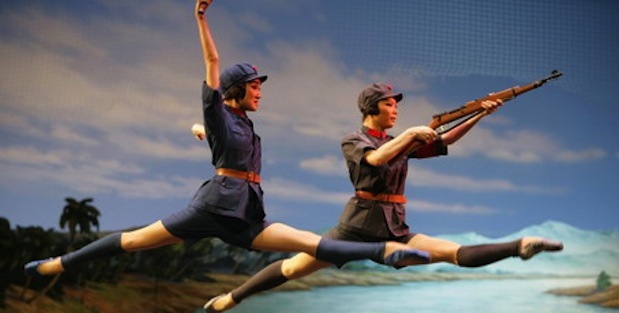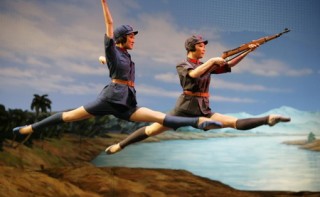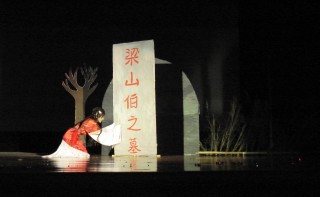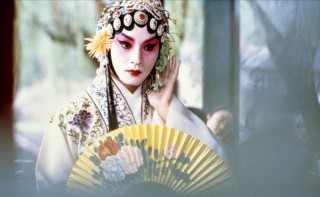The ballet The Red Detachment of Women
Language occupies a province in the realm of culture; therefore, language instruction can be successfully facilitated through cultural vehicles. One avenue for language learning is traced by the arts, and opera in particular. As a historian and head of the arts department, I have been exploring this possibility in part because the French Ministry of National Education has introduced an important new chapter on Chinese history since 1919 in the Terminale (Y12) curriculum. My research suggests that the art form of opera provides a transdisciplinary means of learning Chinese cultural history and the Mandarin language. In the process, students will better grasp the importance of this art form in both Chinese and Western civilization.
Lycée students are familiar with European and American operas, but less so with the Chinese opera. Peking or Beijing Opera developed in the late eighteenth and early nineteenth century out of older forms of musical theater from other regions of China.[1] Today, it is part of the national culture promoted by the China National Peking Opera Company, founded in 1955.[2] After the communist victory in the Chinese civil war (1949), opera also constituted a pillar of Chiang Kai-shek’s Nationalist politics in Taiwan where the Ministry of Defense subsidized the art until 1995.[3]
Beijing opera exalted traditional Confucian values while transmitting traditional Chinese legends and folktales. One classic opera recently performed in Beijing, Farewell my Concubine,[4] juxtaposes the desertion of the Chu king by his soldiers with the loyalty of his concubine who dramatically commits suicide in the climactic scene. Another opera, The Legend of the White Snake, (Ming Dynasty)[5] includes a glorious homecoming by a character who passes the imperial civil service examinations. Europeans discovered the importance of these exams after the sixteenth-century Italian Jesuit missionary Matteo Ricci was solicited by wealthy Chinese families to tutor their children who were studying for the tests.[6]
Musicologists have long recognized the impact of Chinese music on the great Italian composer Giacomo Puccini. More recent inquiries[7] have gone so far as to suggest that that there were Chinese musical inspirations not only for Turandot, which was set in China, but also for Madama Butterfly (1904), which Puccini set in Japan. This season Turandot (1924) is featured at the Metropolitan Opera, where Franco Zeffirelli’s current production boasts resplendent costumes reminiscent of Beijing opera productions.[8]
The political power of opera became evident during the 1960s and set the stage for the Cultural Revolution after 1966. Historian and Deputy Mayor of Beijing Wu Han wrote a subtle critique of Mao’s Great Leap Forward in 1961 entitled Hai Rui Dismissed from Office. In the play, an upright official is dismissed by the Ming emperor for protesting the confiscation of peasants’ land. The opera was set in imperial China, but drew attacks for its thinly veiled allusion to Mao himself and the communists’ policy of rural collectivization.[9]
In 1962 Mao’s wife, the former actress Jiang Qing, turned to directing the arts toward the service of communist aims. She attacked traditional Chinese opera as “feudal” and “bourgeois” while staging new “model operas” that featured peasants denouncing landlords, victorious soldiers of the People’s Liberation Army, and strong independent women characters.[10] Two famous productions included The Legend of the Red Lantern (1963)[11] and a ballet, The Red Detachment of Women, (1964)[12] that was performed during President Nixon’s visit to the People’s Republic of China in 1972. The Sino-American rapprochement generated headlines around the world and inspired John Adams’ 1987 opera Nixon in China.[13]
One of the legacies of the Nixon trip to China has been continued cultural exchange between the two nations. These exchanges take many forms—linguistic, musical, artistic, and theatrical—all of which open pathways to learning the language and history of China. Lycée students and families will write their own chapter in this history of exchanges this winter by opening their homes to students from Fudan High School, Shanghai, and again when Lycée students will visit China in the spring.
[1] Elizabeth Wichmann, “Tradition and Innovation in Contemporary Beijing Opera Performance,” TDR 34 (No. 1, Spring 1990): 146-78, http://www.jstor.org/stable/1146013
[2] China National Peking Opera Company, http://www.cnpoc.cn/en/index.asp
[3] See Nancy Guy’s Peking Opera and Politics in Taiwan (University of Illinois Press, 2005), http://www.press.uillinois.edu/books/catalog/66pqp5xm9780252029738.html
[4] “Beijing Opera – Farewell My Concubine Perform by Catherine Li,” http://www.youtube.com/watch?v=94yCf_ISb0c, accessed 6 January 2013.
[5] The Legend of the White Snake, http://www.youtube.com/watch?v=gCOKXlLH2zs, accessed 6 January 2013.
[6] See the captivating micro-history by Yale historian Jonathan Spence, The Memory Palace of Matteo Ricci (NY: Viking, 1984). “Ming Mnemonics,” New York Times, Book Review, 25 November 1984, http://www.nytimes.com/books/98/12/06/specials/spence-ricci.html
[7] W. Anthony Sheppard, “Music Box as Muse to Puccini’s ‘Butterfly’,” New York Times, 15 June 2012, http://www.nytimes.com/2012/06/17/arts/music/puccini-opera-echoes-a-music-box-at-the-morris-museum.html?pagewanted=all&_r=0, accessed 6 January 2013.
[8] For a sample, visit: “Costume Exhibition at China National Peking Opera Company’s office building,” http://www.cnpoc.cn/en/genInfo.asp?NID=8
[9] J.A.G. Roberts, A History of China, 3rd Edition (NY: Palgrave-Macmillan, 2011), 278ff.
[10] Harold M. Tanner, China: A History, vol. 2 (Indianapolis, IN: Hackett Publishing, 2010), 215.
[11] Model Operas, The Legend of the Red Lantern, http://www.youtube.com/watch?v=Fp67HEavPwc, accessed 6 January 2013.
[12] “Scene from the Red Detachment of Women,” http://www.youtube.com/watch?v=rcRmZ9aX5S4, accessed 6 January 2013.
[13] Metopera.org, “Nixon Arrives at the Met,” http://www.metoperafamily.org/metopera/news/pb_template.aspx?id=14622
About the Author :
Arthur Plaza holds a Ph.D in History and French Studies from New York University. He also studied at Sciences-Po and was awarded a Fulbright Fellowship to conduct research in France in 2004-2005. Part of his research was published in the collective volume entitled “Politiques de la laïcité au XXe siècle” (PUF, 2007). In addition, he has been an editorial assistant at the scholarly journal, French Politics, Culture & Society.






